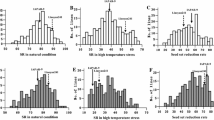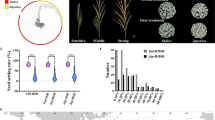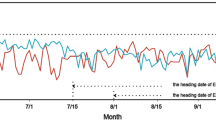Abstract
Global warming threatens many aspects of human life, including a reduction in crop yields, and breeding heat-tolerant crops is a fundamental way to help address this challenge. As food for more than half of the global population, rice (Oryza sativa) has always been a popular research material in plant science. Breeding heat-tolerant rice using genes affording thermotolerance is a fundamental way to address this challenge. In this study, a major QTL, TT1-2, was found to regulate heat tolerance in rice; this QTL was controlled by a single dominant gene. Using F2:3 populations, we narrowed TT1-2 to a 26.0-kb region containing three putative genes, one of which encodes an α2 subunit of the 26S proteasome. This gene was considered the TT1-2 candidate, and the TT1 gene involved in rice heat tolerance was present at this locus. Further analysis showed that the amino acid sequence of the TT1-2 gene had one amino acid difference: arginine (R)-99 was changed to histidine (H), which leads to the formation of a normal alpha-helix. Moreover, through marker-assisted selection and conserved breeding selection, we developed a new male-sterile line, Zhehang 10A, which had a high outcrossing rate, good quality, and strong heat tolerance. We then used Zhehang 10A as the female parent and the restorer line Fuhui 1586 as the male parent and bred a new hybrid, Zhehangyou 1586, which showed high yield, good quality, and strong heat tolerance.







Similar content being viewed by others
References
El-Esawi MA, Alayafi AA (2019) Overexpression of rice Rab7 gene improves drought and heat tolerance and increases grain yield in rice (Oryza sativa L.). Genes 10(1):56
Hasanuzzaman M, Nahar K, Alam MM, Roychowdhury R, Fujita M (2013) Physiological, biochemical, and molecular mechanisms of heat stress tolerance in plants. Int J Mol Sci 14:9643–9684
Inoue T, Higuchi M, Hashimoto Y, Seki M, Kobayashi M, Kato T, Tabata S, Shinozaki K, Kakimoto T (2001) Identification of CRE1 as a cytokinin receptor from Arabidopsis. Nature 409:1060–1063
Khan S, Anwar SM, Ashraf Y et al (2019) Mechanisms and adaptation strategies to improve heat tolerance in rice. A review. Plants 8(11):508
Kilasi NL, Singh J, Vallejos CE et al (2018) Heat stress tolerance in rice (Oryza sativa L.): identification of quantitative trait loci and candidate genes for seedling growth under heat stress. Front Plant Sci 9:1578
Lawas LMF, Xia L, Erban A et al (2019) Metabolic responses of rice cultivars with different tolerance to combined drought and heat stress under field conditions. GigaScience 8:1–21
Li XM, Chao DY, Wu Y, Huang X, Chen K, Cui LG, Su L, Ye WW, Chen H, Chen HC, Dong NQ, Guo T, Shi M, Feng Q, Zhang P, Han B, Shan JX, Gao JP, Lin HX (2015) Natural alleles of a proteasome α2 subunit gene contribute to thermotolerance and adaptation of African rice. Nat Genet 47:827–833
Liu JP, Zhang CC, Wei CC, Liu X, Wang M, Yu F, Xie Q, Tu J (2016) The RING finger ubiquitin E3 ligase OsHTAS enhances heat tolerance by promoting H2O2-induced stomatal closure in rice. Plant Physiol 170:429–443
Lobell DB, Schlenker W, Costa-Roberts J (2011) Climate trends and global crop production since 1980. Science 333:616–620
Lyman NB, Jagadish KSV, Nalley LL, Dixon BL, Siebenmorgen T (2013) Neglecting rice milling yield and quality underestimates economic losses from high-temperature stress. PLoS One 8:e72157
Mba C, Guimaraes EP, Ghosh K (2012) Re-orienting crop improvement for the changing climatic conditions of the 21st century. Agric Food Secur 1:7
McCouch SR, Teytelman L, Xu YB, Lobos KB, Clare K, Walton M, Fu B, Maghirang R, Li Z, Xing Y, Zhang Q, Kono I, Yano M, Fjellstrom R, DeClerck G, Schneider D, Cartinhour S, Ware D, Stein L (2002) Development and mapping of 2240 new SSR markers for rice (Oryza sativa L.). DNA Res 9:199–207
Miyazaki M, Araki M, Okamura K, Ishibashi Y, Yuasa T, Iwaya-Inoue M (2013) Assimilate translocation and expression of sucrose transporter, OsSUT1, contribute to high-performance ripening under heat stress in the heat tolerant rice cultivar Genkitsukushi. J Plant Physiol 170(18):1579–1584
Murray MG, Thompson WF (1980) Rapid isolation of high molecular weight plant DNA. Nucleic Acids Res 8:4321–4326
Panaud O, Chen X, Mccouch SR (1996) Development of microsatellite markers and characterization of simple sequence length polymorphism (SSLP) in rice (Oryza sativa L.). Mol Gen Genet 252:597–607
Ps S, Sv AM, Prakash C et al (2017) High resolution mapping of QTLs for heat tolerance in rice using a 5K SNP array. Rice 10:28
Sakamoto H, Maruyama K, Sakuma Y, Meshi T, Iwabuchi M, Shinozaki K, Yamaguchi-Shinozaki K (2004) Arabidopsis Cys2/His2-type zinc-finger proteins function as transcription repressors under drought, cold, and high-salinity stress conditions1. Plant Physiol 136:2734–2746
Sato H, Todaka D, Kudo M (2016) The Arabidopsis transcriptional regulator DPB3-1 enhances heat stress tolerance without growth retardation in rice. Plant Biotechnol J 14:1756–1767
Semenov MA, Shewry PR (2011) Modelling predicts that heat stress, not drought, will increase vulnerability of wheat in Europe. Sci Rep 1:66
Takeda S, Matsuoka M (2008) Genetic approaches to crop improvement: responding to environmental and population changes. Nat Rev Genet 9:444–457
Trnka M, Rötter RP, Ruiz-Ramos M (2014) Adverse weather conditions for European wheat production will become more frequent with climate change. Nat Clim Chang 4:637–643
Wu X, Shiroto Y, Kishitani S, Ito Y, Toriyama K (2009) Enhanced heat and drought tolerance in transgenic rice seedlings overexpressing OsWRKY11 under the control of HSP101 promoter. Plant Cell Rep 28:21–30
Xi ZY, He FH, Zeng RZ, Zhang ZM, Ding XH, Li WT, Zhang GQ (2006) Development of a wide population of chromosome single-segment substitution lines in the genetic background of an elite cultivar of rice (Oryza sativa L.). Genome 49:476–484
Xu JJ, Zhao Q, Du P et al (2010) Developing high throughput genotyped chromosome segment substitution lines based on population whole-genome re-sequencing in rice (Oryza sativa L.). BMC Genomics 24:656
Zhang CX, Feng BH, Chen TT, Zhang XF, Tao LX, Fu GF (2017) Sugars, antioxidant enzymes and IAA mediate salicylic acid to prevent rice spikelet degeneration caused by heat stress. Plant Growth Regul 83:313–323
Zhao L, Lei J, Huang Y, Zhu S, Chen H, Huang R, Peng Z, Tu Q, Shen X, Yan S (2016) Mapping quantitative trait loci for heat tolerance at anthesis in rice using chromosomal segment substitution lines. Breed Sci 66(3):358–366
Acknowledgments
We thank American Journal Experts for providing professional editing services.
Funding
This work was supported by the National Keypoint Research and Invention Program of the Thirteenth (No. 2017YFD0300102), Special Fund for Agro-scientific Research in the Public Interest of Fujian Province (No. 2020R11010016-3), Youth Technology Innovation Team of Fujian Academy of Agricultural Sciences (No. STIT2017-3-3), Fujian Provincial Natural Science Foundation of China (No. 2019J01011040), and General Project of Fujian Academy of Agricultural Sciences (No. A2017-13).
Author information
Authors and Affiliations
Contributions
CY drafted the manuscript. CY, DY, GZ and HX contributed to the data analysis. DY and CY participated in the design of the study and the interpretation of the results and wrote and edited the manuscript.
Corresponding author
Ethics declarations
Conflict of Interest
The authors declare that they have no conflict of interest.
Additional information
Publisher’s Note
Springer Nature remains neutral with regard to jurisdictional claims in published maps and institutional affiliations.
Key Message
A major QTL, TT1-2, was found to regulate heat tolerance in rice, and a single amino acid difference in the TT1-2 gene could affect the formation of a normal alpha-helix. A new hybrid combination, Zhehangyou 1586, was bred using a developed molecular marker linked to TT1-2.
Rights and permissions
About this article
Cite this article
Yan, C., Zhan, G., Hong, X. et al. Identification and Fine Mapping of a Major QTL, TT1-2, That Plays Significant Roles in Regulating Heat Tolerance in Rice. Plant Mol Biol Rep 39, 376–385 (2021). https://doi.org/10.1007/s11105-020-01256-5
Received:
Accepted:
Published:
Issue Date:
DOI: https://doi.org/10.1007/s11105-020-01256-5




